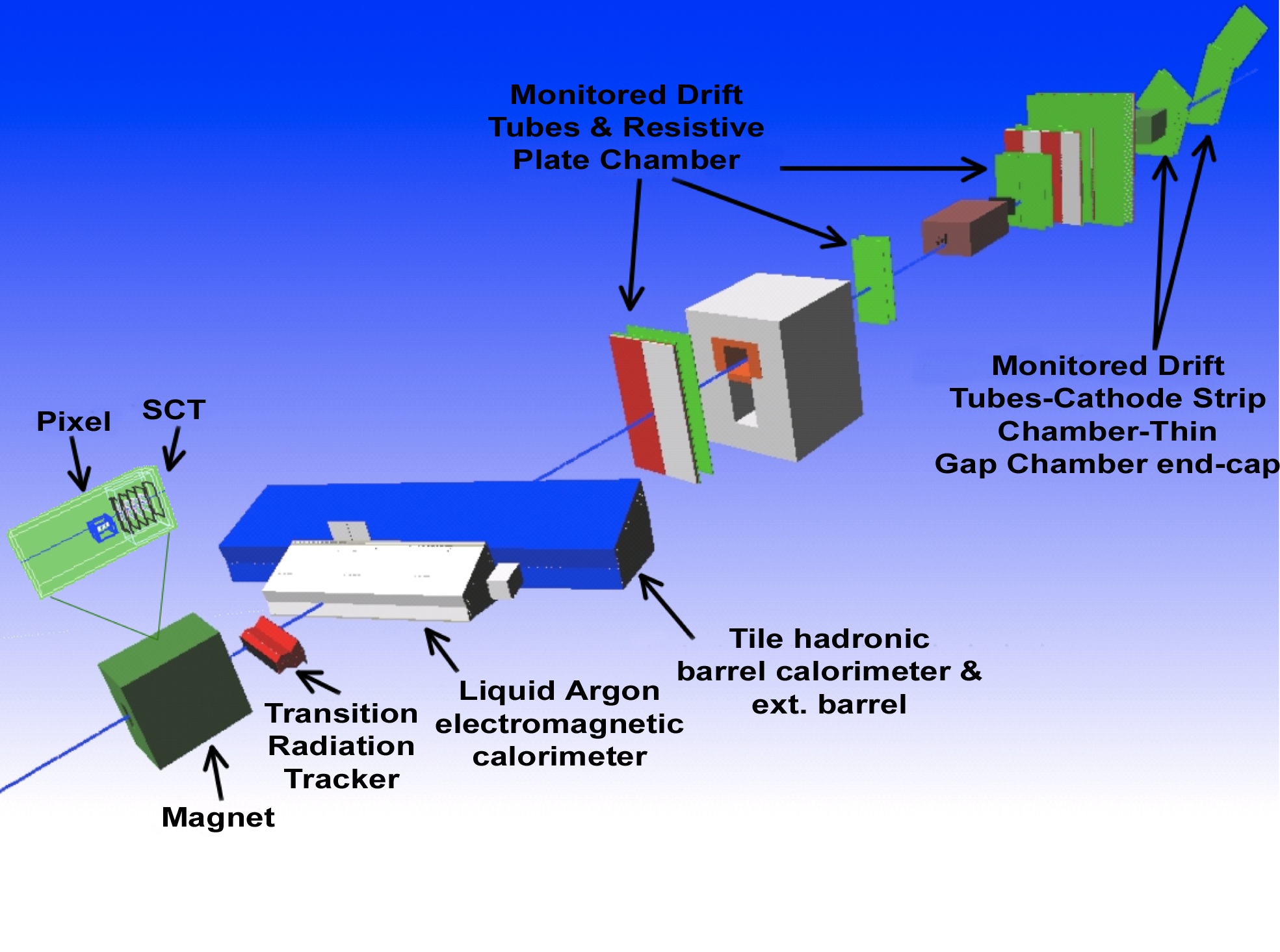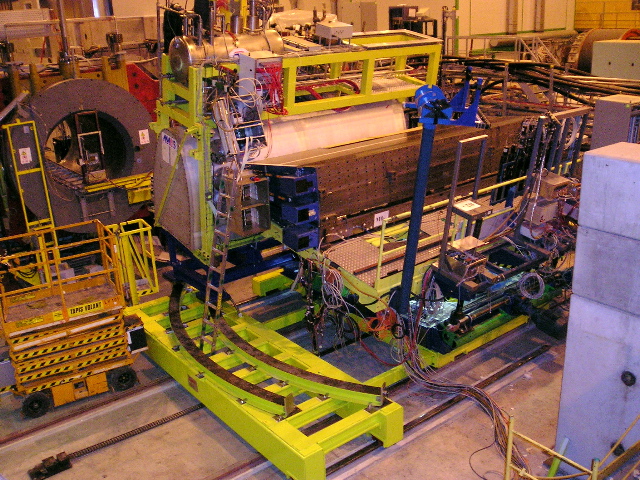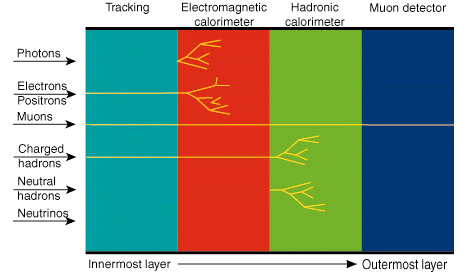Applied Statistics - Project 1
Project description:
Background description:
The ATLAS detector at CERNs new LHC accelerator is a very large and very complex detector consisting of several layers of different detector types, which each perform a series of tasks, which in combination will allow the ATLAS collaboration to explore the proton collisions from the LHC. In order to test if these detectors work properly and are optimized correctly, all parts of the detector were put together as a "slice" of the ATLAS detector, and submitted to an extensive testbeam program. One of the main problems was, that the composition of the beams in terms of particle types is not easily controlled by the accelerator people, and thus have to be determined in situ, that is by the ATLAS detector itself. And that is now the task before you...


Layout of setup (not showing the Cherenkov detector) and the photo of actual situation at CERNs H8 testbeam facility.
The data:
There are two sets of testbeam data, one at an energy of 2 GeV and the other at 9 GeV. For each particle passing into the detector slice, the following numbers (among 100s of others!) were recorded:
- Cherenkov counts (1 number). The Cherenkov counter reacts on particles, which travels faster than the speed of light IN THAT MEDIUM, thus electrons will tend to give a larger signal.
- Transition Radiation Tracker (2 numbers, both integer). Number of hits for tracking in the TRT (first) and number of High Threshold (HT) hits (second) for identifying electrons, since these have a higher chance of creating such a hit.
- ElectroMagnetic Calorimeter (4 numbers). This type of detector stops particles interacting electromagnetically (i.e. electrons), which thus tend to deposit their energy AS EARLY as possible. The four numbers correspond to the energy deposit (in GeV) in each of the 4 layers of the ATLAS EM calorimeter.
- Hadronic Calorimeter (3 numbers). Much thicker than the EM calorimeter, this detector stops all particles except muons with more than 3-4 GeV in energy. Gives no signal, if no particle reaches the detector. Electrons usually don't reach this detector.
- Muon detector (1 number). If a muons passes through, this detector gives a higher signal than when not. However, the coverage of the muon detector used was very small, and thus not all muons gives a signal.
The Cherenkov counter is not part of the ATLAS detector, but simply put into the beam in order to make the task of identifying particles easier. The possible particles are:
- Electrons (Stop early in the EM calorimeter)
- Pions (Stop anywhere between the EM and the hadron calorimeter).
For an illustration of particle interactions:

Suggestive project questions:
Generally, this project is about separating electrons and pions, and seeing how well this can be done. Below are some leading questions, some/most of which your project should cover, but you do not have to follow them blindly.
Your report should be very short (2-3 pages max), explaining how you analysed this data, and what your conclusions were. Possibly a few figures and a table of efficiencies, rejection factors, sample sizes, etc. should/could be included.
Start by considering the 2 GeV data, and the hypothesis that there are only electrons and pions in the sample (which is essentially true!)
- Start by plotting the variables in question! From considering
these, guess/estimate an approximate knowledge of how electrons and
pions distribute themselves in the variables above, and how to make
a selection of these.
Apply a selection in some variables, and see how the others behave.
See if you can make a selection, which gives you a fairly clean
electron and pion sample respectively, and plot these.
Sometimes variables from a single detector are more powerful, when they are combined or taken ratios of. See if some variables from one detector can be combined in this way into a more discriminating single variable (or two), and do so.
- The three detectors, Cherenkov, TRT and ECal are each capable of
separating electrons and pions. But which one is best? Determine
the efficiency and fake rate (i.e. "background efficiency") for
some choice of selection for each of the three detectors, both for
pions and electrons... including statistical errors!
Given the efficiencies and discrimination powers of each cut, try to combine these (assuming that they are independent) into knowledge of your sample purities and also the total number of electrons and pions in the whole sample. Do the sum match the actual number of particles? This is a good cross check!
- If the number of pions was suddenly 1000 that of elections, would
you still be able to get a sample of fairly pure electrons? And if
so, what would the efficiency for these electrons be?
- Now try to measure the correlations betweens the various detectors
for EACH TYPE of particle. Would you expect any correlation? And
does this match what you observe? And how much will any impurities
affect this measurement?
- One of the purposes of the testbeam what to measure the response of
the TRT detector to exactly electrons and pions. Omitting the TRT
from the particle selection, how good is the pion rejection, when
a 90% electron efficiency is required?
- Try to take a sample of events, where there are exactly 33 TRT hits,
and fit the number of HT hits with two Poisson distributions combined.
Do they fit the data? And what is then the probability for a HT hit
for pions and electrons (including errors)?
These probabilities could also be measured simply by selecting pure
samples of pions and electrons using other detectors, and then looking
at the HT probability in these. Which is more precise?
Given your knowledge of the sample purities, you might add a systematic
uncertainty (and correction?) to the latter estimate.
- If you have time, determine these numbers both for the 2 GeV and
the 9 GeV data sample. At which energy is the ATLAS detector best
at e/pi separation, and which detector improves the most with
energy?
- Try to select pions using three different (mutually exclusive) techniques:
a) Passing only a hadronic calorimeter requirement.
b) Passing only Cherenkov AND electromagnetic calorimeter requirements.
c) Passing both a) and b).
Try to measure the HT probability for each of these pion samples. Do they agree with each other?
Data sets:
Below are the files needed for starting the project. The ROOT macro will loop over the data files, but it is for you to write the analysis part.
Comments:
Enjoy, have fun, and throw yourself without worries at the data.
Last updated 24th of September 2010.